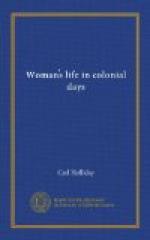“Yet notwithstanding, if you find in yourself an imovable incurable Aversion from him, and cannot love, and honour, and obey him, I shall say no more, nor give you any further trouble in this matter. It had better be off than on. So praying God to pardon us, and pity our Undeserving, and to direct and strengthen and settle you in making a right Judgment, and giving a right Answer, I take leave, who, am, dear child, your loving father...."[250]
IV. The Banns and the Ceremony
After the formal engagement, when the dowry and contract had been agreed upon and signed, the publishing of the banns occurred. Probably this custom was general throughout the colonies; indeed, the Church of England required it in Virginia and South Carolina; the Catholics demanded it in Maryland; the Dutch in New York and the Quakers in Pennsylvania sanctioned it. Sewall mentions the ceremony several times, and evidently looked upon it as a proper, if not a required, procedure.
And who performed the marriage ceremony in those old days? To-day most Americans look upon it as an office of the clergyman, although a few turn to a civil officer in this hour of need; but in the early years of the Plymouth and Massachusetts Bay Colonies it is highly probable that only a magistrate was allowed to marry the contracting parties. Those first American Puritans had a fear of church ceremony, and for some years conducted both weddings and funerals without the formal services of a preacher. By Judge Sewall’s time, either clergyman or magistrate might perform the office; but all symptoms of formality or worldly pomp were frowned upon, and the union was made generally with the utmost simplicity and quietness. We may turn again to the Judge’s Diary for brief pictures of the equally brief ceremony:
“Tuesday, 1688.
Mr. Nath. Newgate Marries Mr. Lynds Daughter
before Mr. Ratcliff,
with Church of England Ceremonies."[251]
“Thorsday, Oct.
4th, 1688. About 5 P.M. Mr. Willard (the
pastor)
married Mr. Samuel Danforth
and Mrs. Hannah Alien."[252]
“Feb. 24, 1717-8.
In the evening I married Joseph Marsh.... I
gave them a glass of
Canary.”
“Apr. 4, 1718....
In the evening I married Chasling Warrick and
Esther Bates...."[253]
It seems that the Judge himself inclined toward the view that a wedding was essentially a civil, and not an ecclesiastical affair, and he even went so far as to introduce a rule having certain magistrates chosen for the duty, but, unluckily, the preachers won the contest and almost took this particular power away from the civil officers. The Judge refers thus to the matter: “Nov. 4, 1692. Law passes for Justices and Ministers Marrying Persons. By order of the Committee, I had drawn up a Bill for Justices and such others as the Assembly should appoint to marry; but came new-drawn and thus alter’d




